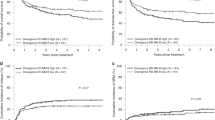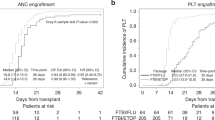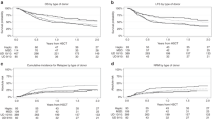Abstract
We have retrospectively analyzed the impact of prognostic factors on the outcome of serologically HLA-matched unrelated donor (UD) BMT for CML. For this purpose, we have studied a cohort of 366 patients transplanted in Europe between January 1985 and December 1994. The median age of the 211 males and 155 females was 34 years; 238 patients were transplanted in first chronic phase and 116 in advanced phases. The median interval from diagnosis to BMT was 827 days. GVHD prophylaxis consisted of CsA and MTX in 202 patients or of ex vivo or in vivo T cell depletion (TCD) in 129. Recently, DNA-based methods of HLA-class II typing have been used to improve donor selection. We obtained complete data on 300 donor/recipient (D/R) pairs. Among them, we have identified three groups of patients, according to specific HLA-DRB1 D/R compatibility. Two hundred and ten patients received marrow from donors identical for HLA-DRB1 (group 1). Thirty-one patients received BMT from a donor who was HLA-DRB1 mismatched (group 2) and 59 from a donor in whom specific HLA-DRB1 typing was not performed (group 3). The overall survival was 37 ± 3% at 2 years and leukemia-free survival (LFS) was 31 ± 3%. In univariate analysis, five variables had a favorable effect on LFS: transplant in first chronic phase (P = 0.0001), time interval from diagnosis to BMT shorter than the median (P = 0.01), prophylaxis of GVHD without TCD (P = 0.001), acute GVHD <grade III (P = 0.0009) and HLA-DRB1 D/R matching (P = 0.0001). Transplant-related mortality (TRM) was 49 ± 4% in group 1, 79 ± 8% in group 2 and 80 ± 6% in group 3 (P = 0.0001). Multivariate analysis confirmed that HLA-DRB1 matching was the most significant factor influencing survival (P = 0.04), LFS (P = 0.013) and TRM (P = 0.0049). From these results, we have defined a ‘good risk’ group, ie patients transplanted in first chronic phase, from an HLA-DRB1 matched donor, without TCD as prophylaxis against GVHD. The 2 year LFS, TRM and relapse incidence for this group were 51 ± 5%, 47 ± 5% and 2 ± 2%, respectively. This suggests that the long-term outcome of patients with favorable prognostic features can approach that of patients transplanted from geno-identical siblings. In contrast, the TRM for patients transplanted for advanced disease from non HLA-DRB1-identical donors was 94%. Such a high TRM clearly indicates that UD BMT is not justifiable for these individuals.
This is a preview of subscription content, access via your institution
Access options
Subscribe to this journal
Receive 12 print issues and online access
$259.00 per year
only $21.58 per issue
Buy this article
- Purchase on SpringerLink
- Instant access to full article PDF
Prices may be subject to local taxes which are calculated during checkout
Similar content being viewed by others
Author information
Authors and Affiliations
Consortia
Rights and permissions
About this article
Cite this article
Devergie, A., Apperley, J., Labopin, M. et al. European results of matched unrelated donor bone marrow transplantation for chronic myeloid leukemia. Impact of HLA class II matching. Bone Marrow Transplant 20, 11–19 (1997). https://doi.org/10.1038/sj.bmt.1700844
Received:
Accepted:
Issue date:
DOI: https://doi.org/10.1038/sj.bmt.1700844
Keywords
This article is cited by
-
Greffes allogéniques à partir de donneurs non apparentés
Oncologie (2007)
-
Impact of HLA matching on outcome of hematopoietic stem cell transplantation in children with inherited diseases: a single-center comparative analysis of genoidentical, haploidentical or unrelated donors
Bone Marrow Transplantation (2004)
-
Dose-dependent effects of in vivo antithymocyte globulin during conditioning for allogeneic bone marrow transplantation from unrelated donors in patients with chronic phase CML
Bone Marrow Transplantation (2003)
-
Common genomic HLA haplotypes contributing to successful donor search in unrelated hematopoietic transplantation
Bone Marrow Transplantation (2003)
-
Chronic myeloid leukemia: Pathophysiology, diagnostic parameters, and current treatment concepts
Wiener Klinische Wochenschrift (2003)



